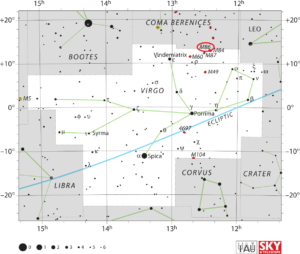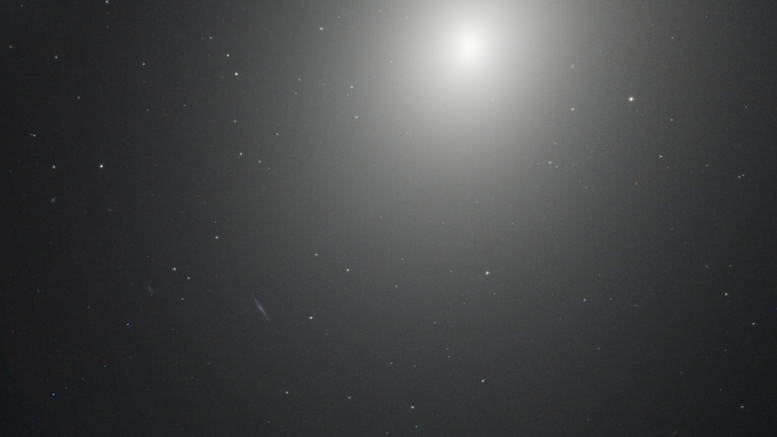Messier 86 is an elliptical or lenticular galaxy in the constellation Virgo. It has the highest blueshift of all Messier objects.
| Description | |
| Visible From Pacific Northwest | December To May |
| Best Time To Observe | May |
| Minimum Size Of Viewing Device | Small Telescope |
| Object Type | Elliptical Or Lenticular Galaxy |
| Designations | Messier 86, M86, NGC 4406, PGC 40653, VCC 0881, UGC 7532, GIN 780, 2E 2707, 2E 1223.6+1312, IRAS 12234+1315, 2MASX J12261181+1256454, MCG+02-32-046, FAUST V051, VCC 881, VPC 454, Z 70-72, Z 1223.7+1314 |
| Right Ascension | 12h 26m 11.7s |
| Declination | +12°56’46” |
| Constellation | Virgo |
| Number Of Stars | More Than 400 Billion |
| Apparent magnitude | +9.8 |
| Apparent dimensions | 8′.9 x 5′.8 |
| Object Radius | 67,500 light years |
| Distance From Earth | 52 million light years |
History
Messier 86 was discovered by Charles Messier on March 18, 1781. On the same night, Messier also discovered and catalogued seven other galaxies in the Virgo Cluster – Messier 84, Messier 85, Messier 87 (Virgo A), Messier 88, Messier 89, Messier 90, and Messier 91 – as well as the globular cluster Messier 92, located in the constellation Hercules.
Messier described his 86th catalogue entry as a “nebula without star, in Virgo, on the parallel & very near to the nebula above, No. 84 [Messier 84]: their appearances are the same, & both appear together in the same field of the telescope.”
John Herschel catalogued M86 as h 1253 and later added it to the General Catalogue as GC 2961. He described the object as “very bright; large; round; gradually brighter toward the middle where there is a nucleus; mottled.”
Locating M86 In The Sky
The galaxy lies close to the border with Coma Berenices and can be found almost exactly halfway along the line from the bright star Denebola in Leo to Vindemiatrix in Virgo. It appears in the same field with the nearby Messier 84, positioned 17 arc minutes west. The giant elliptical galaxy Virgo A (M87) is only 1 degree southeast of the pair.

Viewing M86
The galaxy can be seen in 10×50 binoculars under good conditions, but only appears as a faint patch of light. Small and medium-sized telescopes show an oval-shaped patch with a brighter centre, while larger instruments provide a better view of the galaxy’s halo. 8-inch telescopes will reveal several fainter galaxies in the same field of view on a clear night. The best time of year to observe the galaxies is during the spring.
Photographing M86
Markarian’s Chain is a fantastic target for almost any type of instrument and camera. It is large enough to be photographed with small to medium size telescopes, and you can even capture it with just a DSLR camera and a telephoto lens! Bringing out the detail can be a bit challenging, but it is worth it. The best way to get guidance is to look at the link below or use astobin or cloudynights for a similar setup.
http://www.astroimages.de/en/gallery/M86.html
https://www.galactic-hunter.com/post/markarians-chain
Sources And Further Reading
Descriptions of all of Messier Objects can be found here.
https://freestarcharts.com/messier-86
https://www.nasa.gov/feature/goddard/2018/messier-86
http://www.messier.seds.org/m/m086.html

Be the first to comment on "Messier 86"